
The Pan Am trans-Pacific air mail service FAM 19 between Auckland and San Francisco was suspended in December 1941 after the attack on Pearl Harbor. That meant that there was no longer an all air service between New Zealand and Britain.
With the cut in the Horseshoe Route in February 1942, the surface route across the Pacific became very important. There were two routes:
- by sea to San Francisco and then by air to the UK at a cost of 2s 6d;
- by sea to Panama and then by air to the UK via New York at a cost of 3s 6d.
The route from the UK was by the reverse of the first of these routes from February 1942 until September 1944 and then by the reverse of the second route until late 1945 [1]. The rate in both cases was 1s 3d.
The full air mail service to the USA and Canada at a cost of 4s 0d was restored in September 1945 and the partial air services
terminated.
By that time, air mail to the UK was being sent by the Indian Ocean Route
at a cost of 1s 6d.
San Francisco - UK leg by air: September '41-'44: rate 2s 6d
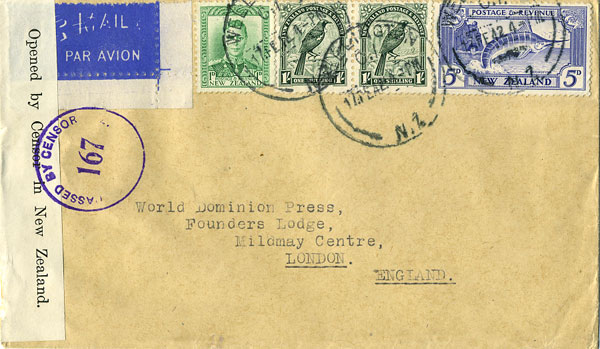
From 2 September, 1941 airmail at the 2s 6d rate went by surface to San Francisco. This service continued after the USA entered WW2.
The mail was flown from San Francisco to New York and then on FAM 18 from New York [2]. Up until May 1942 this was to Lisbon with onward transmission to the UK by BOAC or KLM. From May 1942 FAM 18 was to Foynes (Shannon) in Ireland via Lisbon in the winter and via Canada in the summer. From Shannon, there was a landplane connecting service with the UK.
This censored cover to the UK is postmarked in Wellington on 17 February 1942 and is
franked with 2s 6d.
Although it has no routing instructions, it presumably went by sea to San Francisco
and then flown on FAM 18 to Lisbon.
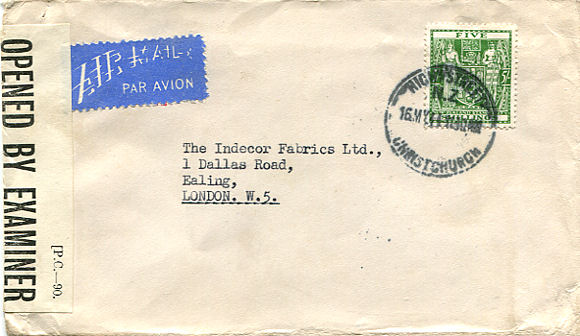

Although this service from New Zealand continued until July 1944 [3], there was a lack of shipping between New Zealand and the USA and so the service provided was erratic.
Legg [5] gives an example 1942 transit time via the similar route from Australia to UK via USA of 66 days. The similar service from Australia cost 2s 1d.
This censored cover from Christchurch on 16 May 1944, franked at 5s 0d with
double the rate is a late use of the service.
It would be flown from New York to Foynes in Ireland via Canada and then from Foynes to the UK.
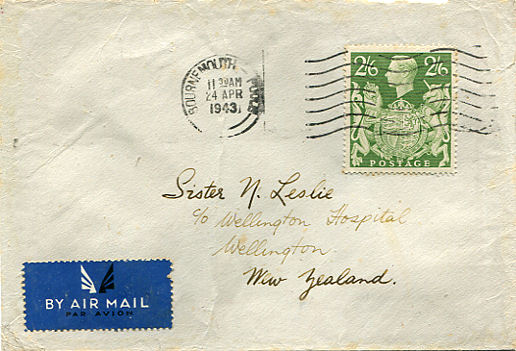
From UK
From February 1942 mail from UK to New Zealand was sent by this route at a cost of 1s 3d which was only half the cost from New Zealand.
This cover from the UK to New Zealand was postmarked in Bournemouth on 24 April 1943. It is franked with 2s 6d and so was overweight. It would have been flown on the Winter Route which was Bristol - Shannon by landplane and then Foynes - Lisbon - West Africa - South America - New York by flying boat.
From 22nd September 1944, air mail from UK to New Zealand and Australia was flown to the Canal Zone via New York and sent from there across the Pacific by sea. The rate remained at 1s 3d. Average transit time was 5½ weeks.
The route via Panama had been available from New Zealand since January 1942
at a rate of 3s 6d.
New Zealand - USA via Panama '38 -'44: rate 1s 3d
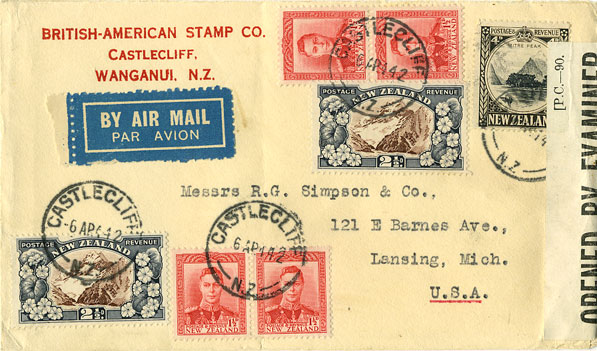
To USA
With the end of the Horseshoe Route from Australia and the Pan American route across the Pacific, a new air mail service to UK and Europe was started in January 1942. Mail was sent by sea to the Canal Zone and then by air from Panama to New York via Miami followed by trans-Atlantic by air. The cost was 3s 6d [3].
The service via Panama had been available to the USA and Canada since 1938 at a rate of 1s 3d, but there was now a significant increase in its use.
This cover to the USA is franked with 1s 3d and so went
by sea to Panama before being flown to the USA.
It appears to be postmarked on 6 April 1942, but the first use of the Opened by
Examiner DDA censor label is 23 December 1942 [4].
Perhaps the actual year is 44 as the character in front of the 42
could be a 4.

To Canada
This cover to Canada is postmarked in Wellington on 14 April 1944 and is franked with 1s 5d. As the rate to Canada by sea to Panama and then by air to Canada was 1s 3d, the cover appears to be overfranked.
This air mail route was ended in September 1945 and the air mail service from New Zealand to the USA at a rate of 4s 0d was reintroduced.
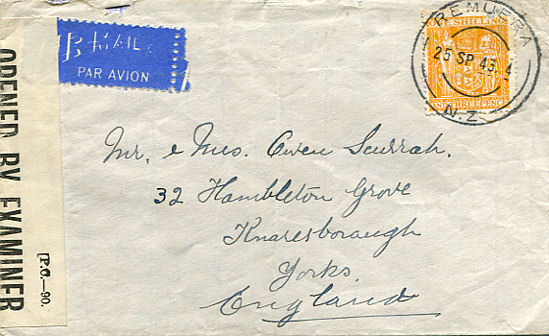
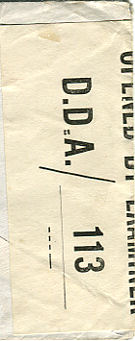
To UK
This air mail cover to the UK in September 1943 is franked with 1s 3d. There was no advertised air mail service to the UK at this rate, but a possibility is that the intention was that it would be sent by sea to Panama and then flown to New York before completing its journey by sea across the Atlantic.
The 3s 6d rate described below went by this route to New York although the mail
was then flown across the Atlantic.
New Zealand - USA (- Europe) via Panama January '42-'44: rate 3s 6d
1942 - 1944 Transatlantic Summer Route via Canada
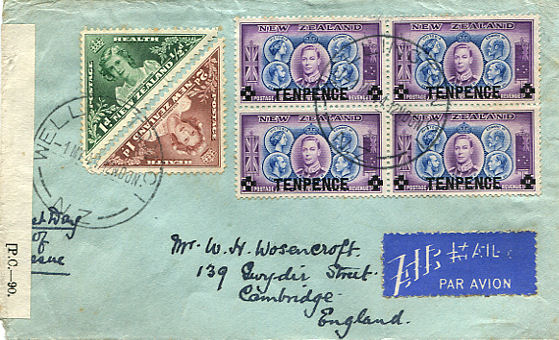
To UK
This censored cover is postmarked on 1 May 1944 in Wellington and addressed to UK. It was sent by sea to Panama, flown from there to New York and finally flown transatlantic by the FAM 18 summer route that was New York - Canada - Foynes (Shannon).
It was then flown by BOAC from Shannon to Croydon. (In 1942 and 1943 that service was to Bristol.)
The franking is 4 x 10d Centennial surcharge (first day of issue) plus the 1943 Health stamps.
The overfranking by a 1d is probably due to the sender wanting to include both health stamps for philatelic reasons.
1942 - 1944 Transatlantic Winter Route via Lisbon
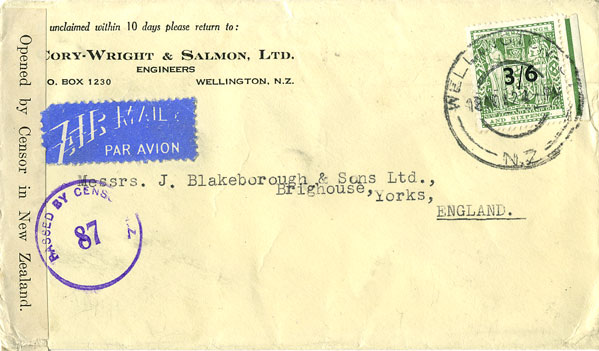
To UK
This censored cover is postmarked on 18 November 1942 in Wellington and addressed to UK. As it is franked with 3s 6d, it was sent by sea to Panama, was then flown to New York and finally flown transatlantic by the winter route that was New York - Bermuda - Azores - Lisbon - Foynes (Shannon). It was then flown from Shannon to Bristol.
It is franked with the 3/6 on 3s 6d postal fiscal stamp which was commonly used to frank letters sent on this service.
The censor tape is Opened by Censor in New Zealand on two lines as the DDA censor tape was not introduced until the following month.
Although the service to USA continued, the service to UK via Panama
ended in July 1944 and was replaced by a service by TEAL
to Australia, Qantas to Perth, then sea to Ceylon followed by
BOAC to the UK [3].
Transit times
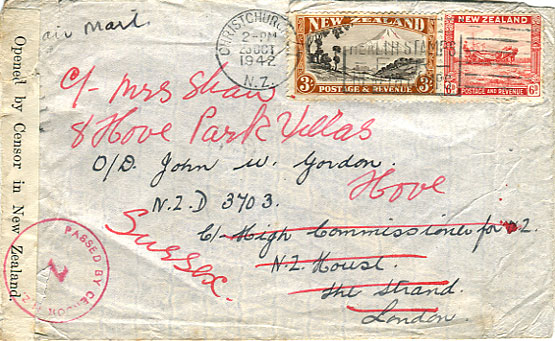
According to Startup [3], the estimated transit time to the UK was between 25 and 35 days. With the problems of war, mail often took longer than expected and so it is always interesting to look at covers that were either re-directed on arrival or have registered receiving marks.
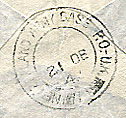
This rather crumpled cover is postmarked in Christchurch on 23 October 1942 and was censored there (censor no 7). Most censor marks were in purple, but some from Christchurch, like this one, are in red.
It is addressed to New Zealand House in London and was redirected with a
New Zealand Army Base P. O. - U.K. handstamp to Hove 59
days later on 21 December.
It therefore got caught up in, and was delayed, with the Christmas post
which was always heavier and put extra strains on the system.
This next cover is addressed to Northern Ireland and, as it is registered, is franked with 3s 10d, i.e. the 3s 6d rate via Panama plus 4d registration fee. It is postmarked in Wellington on 11 January 1943 and was backstamped in London 38 days later on 18 February.

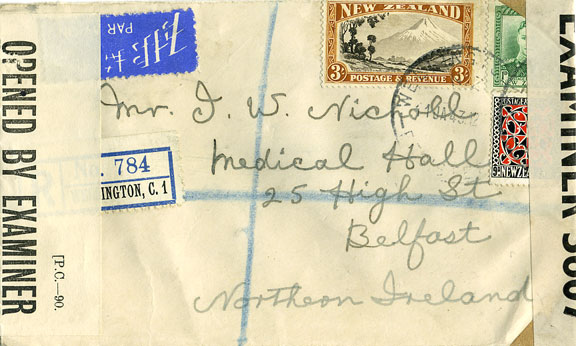
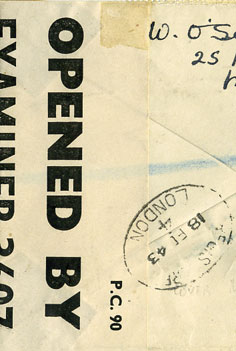
The cover was censored twice, first in New Zealand (DDA 30 was a Wellington censor code [2]) and then in the UK. A standard censor label system had been introduced throughout the British Empire with a 1, 2 or 3 letter code indicating the country. DDA was the code for New Zealand while DA was Australia.
The service from the UK used this route via Panama from September 1944. Even that service was not fast and mail took an average of 40 days [1].
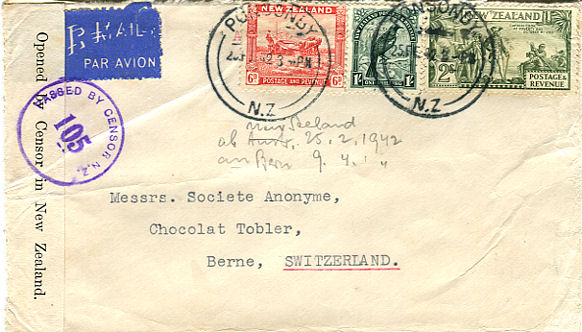
To Switzerland
This cover at the 3s 6d rate is postmarked in Ponsonby, New Zealand on 25 February 1942 and was opened by the censors in Auckland (no 105). Business mail from New Zealand to Switzerland at this time is relatively uncommon with most mail being to the Red Cross in Geneva.
After going by sea to Panama, it would have been flown to New York and from there to Lisbon.
It is likely to have been sent to Switzerland via Vichy France which
is why it has no further censor marks.
The cover has the date of 9 April in manuscript indicating when it was received in Berne.
That would make a transit time of 43 days.
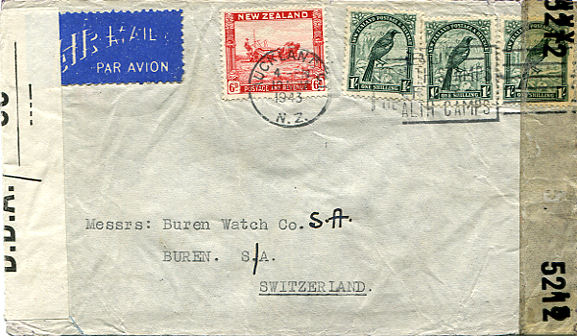
To Switzerland - German Censor
This cover, postmarked in Auckland on 10 November 1943, is a commercial cover addressed to Switzerland at the 3s 6d rate.
It was opened three times by the censors. It has a New Zealand DDA 89 (Auckland) censor label on the left, a USA label (censor number 5212 used in New York) on the right and a German label on the back.
After going by sea to Panama, it would have been flown to
New York and from there to Lisbon.
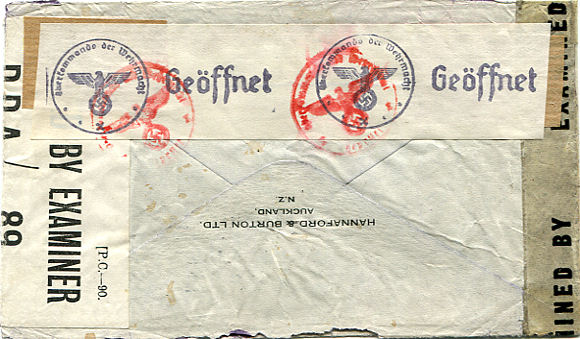
The German censor tape has an X under the swastika at the bottom of the printed circle inscribed Oberkommando der Wehrmacht. That is the letter code used by the German censors in Paris.
The route from Lisbon is likely to have been air to Barcelona and then rail to German-occupied Paris and from there by rail to Switzerland.
Earlier in the war, mail could be sent through Vichy France and therefore avoid
German censorship, but in November 1942, the Germans occupied southern France.
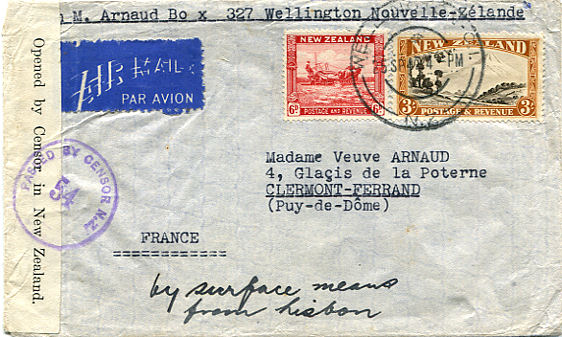
To France
Cover postmarked in Wellington on 25 September 1942 and opened by the censor there. There is by surface means from Lisbon in manuscript on the front. According to [2], censor number 54 was used in Wellington for POW mails.
It has a B alpha control mark which was used for internal communication within the censor office when there was something special about a cover. In this case, it is presumably because it is addressed to Vichy France.
There are no further censor marks.
Vichy France was occupied by the Germans on 10 November 1942, i.e. 46 days after this cover was posted.
This was therefore likely to be one of the last covers to escape German censorship before the Germans
arranged for mail to Vichy France from Lisbon to be sent to Paris to be censored.
Dominica - New Zealand March 1943: franked 5s 9d
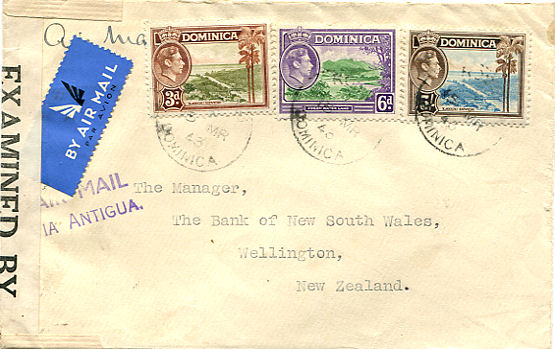
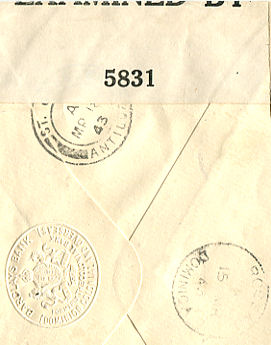
This cover from Barclays Bank in Dominica is postmarked on 15 March 1943 and is addressed to a bank in New Zealand. It has the routing instructions Air Mail / via Antigua (applied to covers intended to be flown north by Pan Am [9]) and has an Antigua backstamp on 18 March. It was examined by the censor in New York, but has no further transit marks.
The franking of 5s 9d is high which suggests that it was intended to be flown for most of its journey. That suggests an intended route of: air from Antigua to Trinidad, air from Trinidad to West Africa by Pan American to Lagos and from there by air across Africa to Cairo, connecting with the Horseshoe Route. Then by sea to Australia from Egypt or from India and finally flown across Australia and to New Zealand.
However, the reality is likely to be that it went from Antigua to New York
by air, was flown across the USA and then completed its journey across the Pacific to New Zealand by sea.
It seems grossly overfranked for that route as the rate from Dominica to the USA was only 1s 2d.
New Zealand - USA May 1944: route unclear
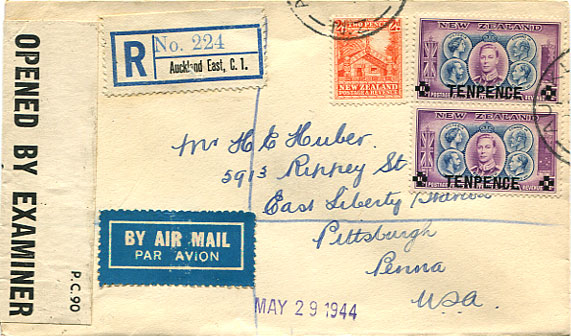
As described above, the main (partial) air mail route from New Zealand to USA was sea to Canal Zone followed by air from Panama to New York at a rate of 1s 3d. This service, as part of a 3s 6d service to UK, ended in July 1944 and was replaced by a route via Australia to UK at a rate of 1s 6d [3].
This registered cover from Auckland to Pittsburg, Pennsylvania is franked with 1s 10d which would appear to be 4d registration fee plus 1s 6d air mail postage. The Auckland postmarks are mostly off the cover and so the exact date of postage is unknown. However, it is franked with two 10d surcharges on the 1½d Centennial that was not issued until 1 May 1944 and there are San Pedro and Pittsburg backstamps on 26 and 29 May 1944 respectively.
The situation is complicated by the presence of the censor label
IE 8056 as IE was the censor code for Trinidad [7].
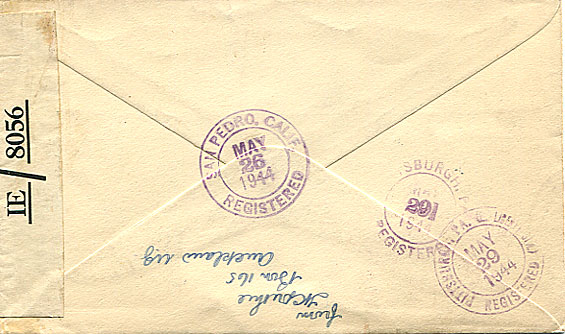
The route from Trinidad is clear: by sea through the Panama Canal to San Pedro in California. Then from San Pedro to Pittsburg which took 3 days.
So how did it get from New Zealand to Trinidad? It was a maximum of 25 days (1 May - 26 May) from New Zealand to San Pedro via Trinidad. Given that the 1s 6d route to UK via Australia had not yet been opened and the fast delivery time, it must have been sent across the Pacific to the Canal Zone. The notion of it being sent to Trinidad from New Zealand via Australia, across the Indian Ocean to Ceylon, then to Cairo, from there to West Africa and then trans-Atlantic by Pan American to Trinidad seems extremely unlikely.
Instead of then been flown from there to New York,
it was then sent to Trinidad.
(Perhaps the ship from New Zealand was to the UK via the Panama Canal and Trinidad and
it failed to be off-loaded, or they thought that it could be flown
by Pan American from Trinidad to USA or they thought that as it
was addressed to a person with a German sounding name it should be censored.
Trinidad was a major censor station at that time.)
Whatever reason, once it got to Trinidad, it was sent back through the Panama
Canal and on to San Pedro.
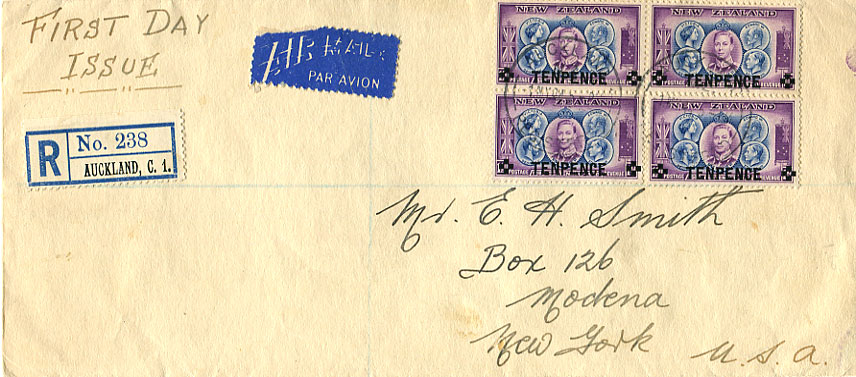
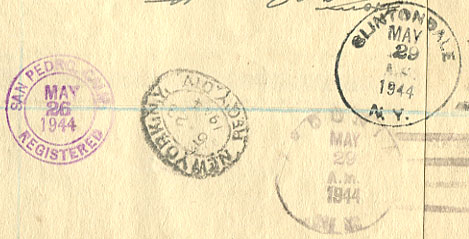
As a comparison, this cover was posted on 1 May 1944, the first day of the 10d surcharge issue. It is franked with 3s 4d. If that is intentional then it would appear to be double 1s 6d plus 4d registration which has similarities with the first cover.
It has a San Pedro transit mark on 26 May, a New York transit on 28 May and an arrival mark on 29 May. It therefore arrived in San Pedro on the same day as the previous cover which makes the timing of its detour to Trinidad even more difficult to understand.
A possible scenario is that they both went to Panama on the same ship; the first cover then had its detour to Trinidad, but was sent back to Panama in time to go on the same ship from Panama to San Pedro?
I have seen registered first day covers sent to the USA by surface mail that have San Pedro backstamps on 27 May. Could they have been on the same ship, but the air mail was given priority in being processed and the surface mail had to wait until the following day?
All very strange.
Fast for surface mail?
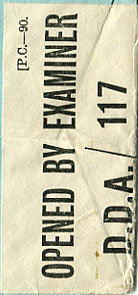
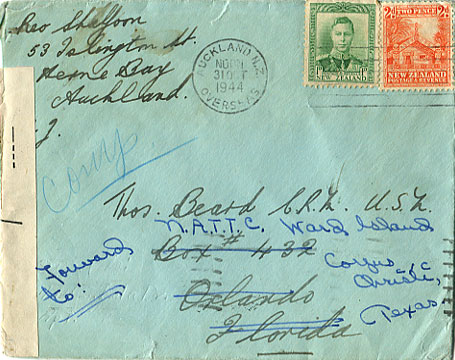
This censored cover is postmarked in Auckland on 31 October 1944 and then re-directed in Orlando, Florida on 18 November.

In 1940, the regular sea route from Auckland to San Francisco took 15 days while surface mail from the west to the east coast of the USA took 3 days giving a total of 18 days although perhaps one day can be deducted due to crossing the International Date Line. It is unlikely that there would have been a major change in that timing by 1944. The alternative was by sea to the Canal Zone and from there to Florida.
So, this cover must have been sent immediately before a sailing from Auckland, for it to have arrived in Orlando so soon.
The re-direction is to N.A.T.T.C. which stands for
Naval Aviation Technical Training Center.
They had a base in Ward Island.
[1] Further Wartime Interruptions to Air Mail Routes, Bill Legg,
Air Mail News, vol 47, pp 188-192, November 2004.
[2] The Postal History of World War II Mail between New
Zealand and Switzerland, R.M. Startup and C.J. LaBlonde, 2005.
[3] Airmails of New Zealand, volume 3, R.M. Startup, 1997.
[4] Civilian Postal Censorship in World War II Some Facts and Problems,
G. Branam, The Kiwi, vol 43, pp 90-97, September 1994.
[5] Wartime Interruptions to Air Mail Routes, W.H. Legg,
Air Mail News, vol 47, pp 46-53, May 2004.
[6] Airmail Routes and Rates for P.O.W Mail in World War II,
G Branam, The Kiwi, vol 38, pp 34-38, March 1989.
[7] World War II Censor Marks, J.A Daynes (editor), The Forces Postal
History Society, 1986.
[8] Pacific Air Mails, R.M. Startup,
The Mail Coach, vol 14, pp 175-184, April 1978.
[9] Air Mail Operations During World War II, T.H. Boyle, American Air Mail Society, 1998.